Is the Novoflex adapter worth a three digit figure when I can get one from China for 10 bucks? That was the question I had in mind when I bought it.
Currently I don’t own a single lens with an E-mount for my Sony Alpha 7, so every lens I use is adapted and I use adapters all the time. Over the last three years I have gained some experience with cheap adapters but I hadn’t used one of the more expensive ones. So I decided to buy a Novoflex NEX/CAN adapter, which was made in Germany and put it to the test.
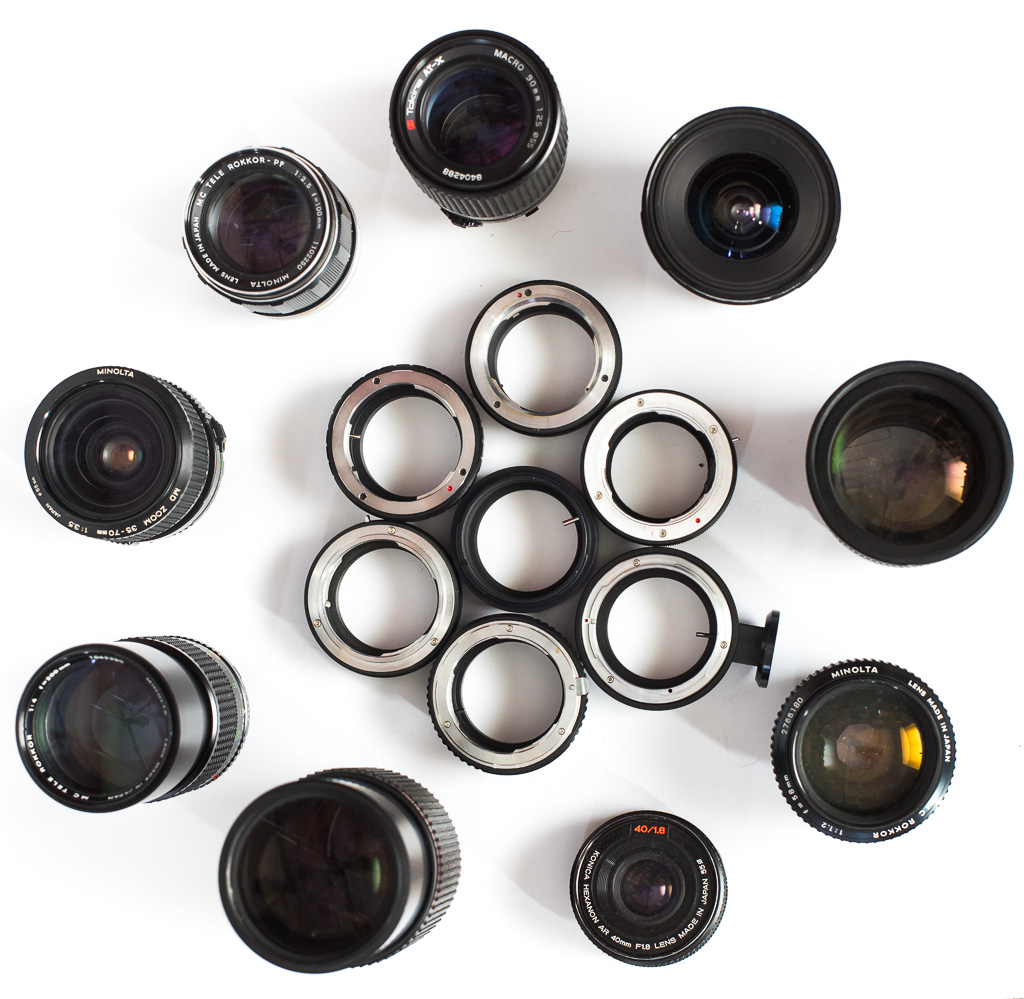
Material
The adapter is made from one piece of aluminium and coated black. I think it is anodized but I am not sure. It was much harder to scratch it with a sharp needle, than my cheap adapters.
I was a bit worried that aluminium would be less durable than chromed brass but the Novoflex support assured me that there hadn’t been a single case were someone had problems with the durability and after 4 months I see no signs of wear.
Design
The design of the adapter is rather clever. Unlike my cheap FD adapters there are no moving parts on this adapter to engage the aperture mechanism of a FD lens.
Attaching the adapter to a FD lens is a bit tricky, there is a white and a red dot on the adapter. At first you have to align the white dot with the red dot of the lens, then you turn the adapter for about 25 degrees anti-clockwise until the red dot of the adapter sits above the red dot of the lens. Now you can turn the adapter 80 degrees clockwise and the adapter is installed. This sounds much more complicated than it is in practice.
For me this design has two advantages over other designs:
- No moving parts means that the adapter is more reliable
- Once attached you can be sure that the lens I stopped down to the aperture you set. I prefer this design a lot over that of my $10 adapters were I have a moving ring which has two settings: LOCK and OPEN. When attaching the lens it has to be set to OPEN and to stop the lens down you have to set it to LOCK. On one of my cheap adapter this mechanism got loose and I have lost some nice pictures because I believed that my FD 2.8/20 was at f/11 while actually was at f/2.8 which ruined the shot and when I noticed, it was too late to retake it.
Infinity focus
With adapters for DSLRs you often have problems with infinity focus because adapters are too thick. With E-mount adapters most are a little bit too thin which is less of a problem, you still can reach infinity focus, you can actually focus “behind infinity”. But the distance scale of you lens will be off.
Here I saw a big variance between my cheap adapters, some were a little short, some quite a bit and some had the right thickness so that you are focused at infinity when you have reached the hard stop of the lens. You can adjust it on most adapters though with a screwdriver, patience and some tinfoil.
The Novoflex adapter is very precisely made and has the correct thickness so that my FD 1.4/50 or 2.8/20 are at infinity when I hit the hard stop. This is more important to me than I though before because now I can actually use the hard stop when I am shooting stars at night or work with the hyper focal distance.
Accuracy of fit
With cheap adapters I saw a high variance in how well they fit. I had one adapter which was very hard to get off my camera without damaging my a7. Then there were adapters which had so much play that the whole lens moved when I turned the focusing ring.
Most of my adapters are precise enough, there is a little bit of play when I try to turn the lens but in practice it is not a real issue.
The Novoflex adapter fits noticeably better than all my cheap adapters, there is zero play and lens, adapter and camera feel like one unit.
Alignment
Some time ago Roger Cicala put several adapters to the test on his optical bench and found that – without exception – ever adapter caused a quite noticeable drop of sharpness in at least one corner. He concluded that in the real world the problem would be far less noticeable but would probably show up in a wideangle/landscape scenario.
So I tried to recreate the problem in the real world but I failed. I used my FD 2.8/20 lens at f/11 and applied my usual decentering test but all the corners were very similar in sharpness even with the cheap adapters.
I think this is more likely to be an issue when modern lenses like the Samyang 2.8/14 or Zeiss 2.8/21 Distagon are used which – unlike my FD 2.8/20 – have sharp corners from f/2.8. In fact Helge from 3d-kraft.com told me that he had to replace his cheap adapter with a Novoflex adapter when testing the Zeiss 2.8/15 because the cheap adapter caused decentering like issues.
Reflections
There were quite a few reports about reflection issues with the Metabones Smart EF to E-mount adapters so I was curious if Novoflex had this issue under control.
A short look at the adapter showed a significant difference between the Novoflex and my cheap adapters: While the cheap ones have a rather reflective inner side the Novoflex absorbs light much better.
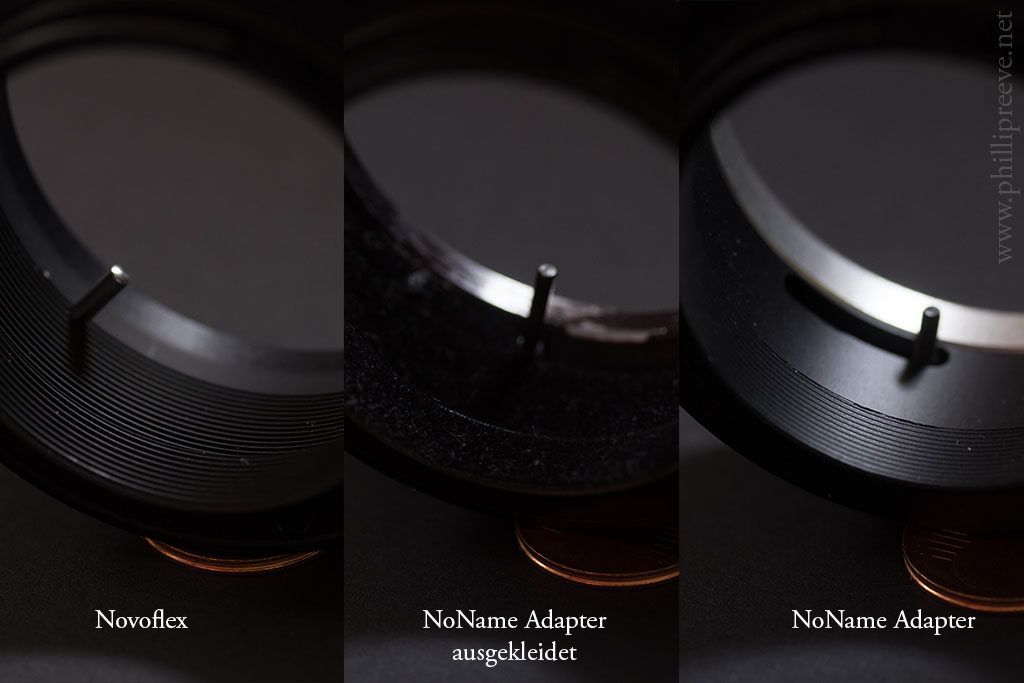
You will also notice that a cheap adapter which I have coated with an light absorbing material reflects even less light.
In the field it wasn’t easy to find a situation were even the cheap adapter caused any issues but when I found one the Novoflex fared much better. It showed a very moderate contrast loss compared to my coated adapter but very far from the uncoated adapters nasty reflections
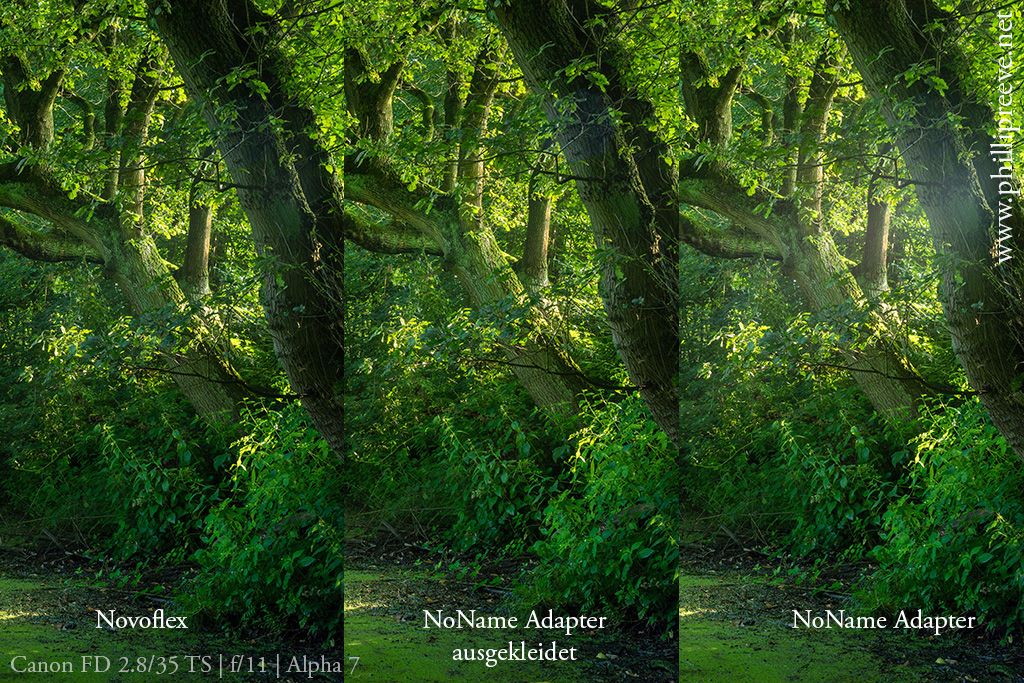
Tripod Mount ASTAT-NEX
Because the a7 is a small camera I don’t like to put medium large lenses which don’t have a tripod mount of their own like my Canon FD 4/80-200 L on the tripod mounted camera. I want an adapter with a tripod mount for better stabilization and less stress on the camera mount.
There is a tripod collar from Novoflex for their adapters which is as expensive as the adapter. I didn’t buy it because I already own a cheap adapter with a tripod mount which does the job well enough for now.
From what I read about the Novoflex ASTAT-NEX it is as well made as the adapter, rock solid and well designed. You can also change the lens from landscape orientation to portrait orientation, my cheap adapter can’t do that.
For reviews and prices check it out on Amazon.com or Amazon.de
Conclusion Novoflex Adapter
Is this adapter worth that much money? I think it is. It performed very well in every aspect and whenever I use a FD lens I will make sure that the Novoflex ist attached. This is because I don’t have to think about the adapter, it just works.
You don’t need this adapter to take nice images. Images taken with cheap adapters will look the same. So if you have a very limited budget buy them, you could have some hassle with them but more often than not they work fine and many of the issues are fixable and you can buy 10 adapters for the price of one Novoflex.
What I like a lot about the Novoflex is that I don’t have to worry about the adapter. I know that I set the lens to infinity and it will be at infinity, there are no movable parts which could break, there won’t be any reflection issues and it fits very well.
Affiliate Links
If you consider buying this adapter please use one of my affiliate links, it is an easy and effective way to support me.
Canon FD to E-Mount Amazon.com | Amazon.de
Minolta MD/MC to E-Mount Amazon.com | Amazon.de
Leica R to E-Mount Amazon.com | Amazon.de
Olympus OM to E-Mount Amazon.com | Amazon.de
Other mounts to E-Mount Amazon.com | Amazon.de
This site contains affiliate links. If you make a purchase using any of the links marked as affiliate links, I may receive a small commission at no additional cost to you. This helps support the creation of future content.
Latest posts by Phillip Reeve (see all)
- Review: Samyang AF 75/1.8 FE - April 12, 2021
- The FE-List now has 113 lenses on it - March 25, 2021
- 2020 – Year’s end review - December 28, 2020
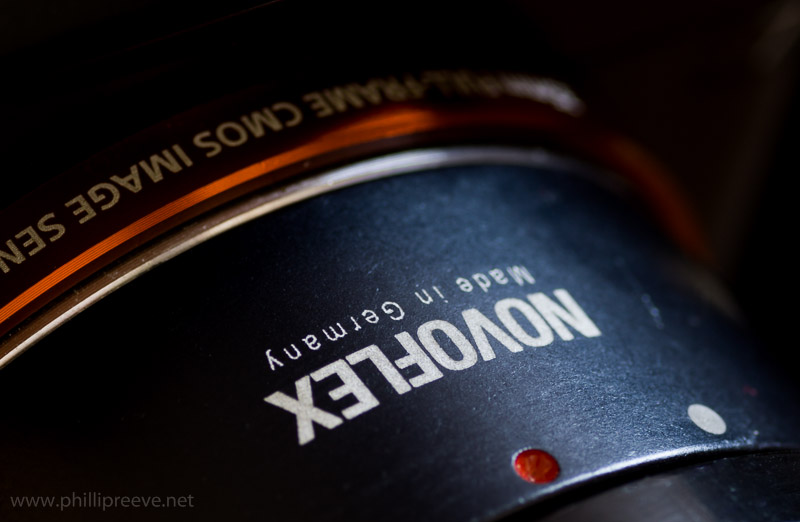
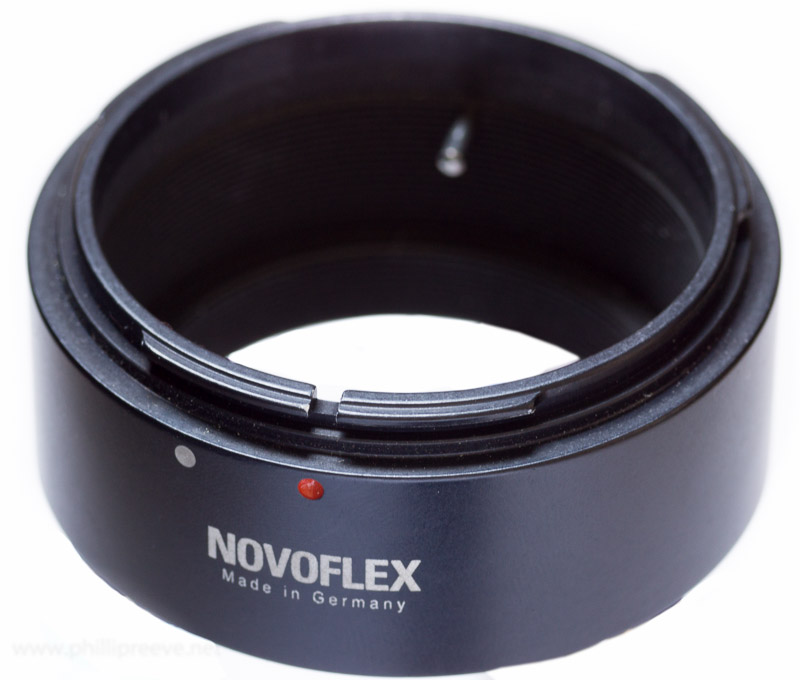
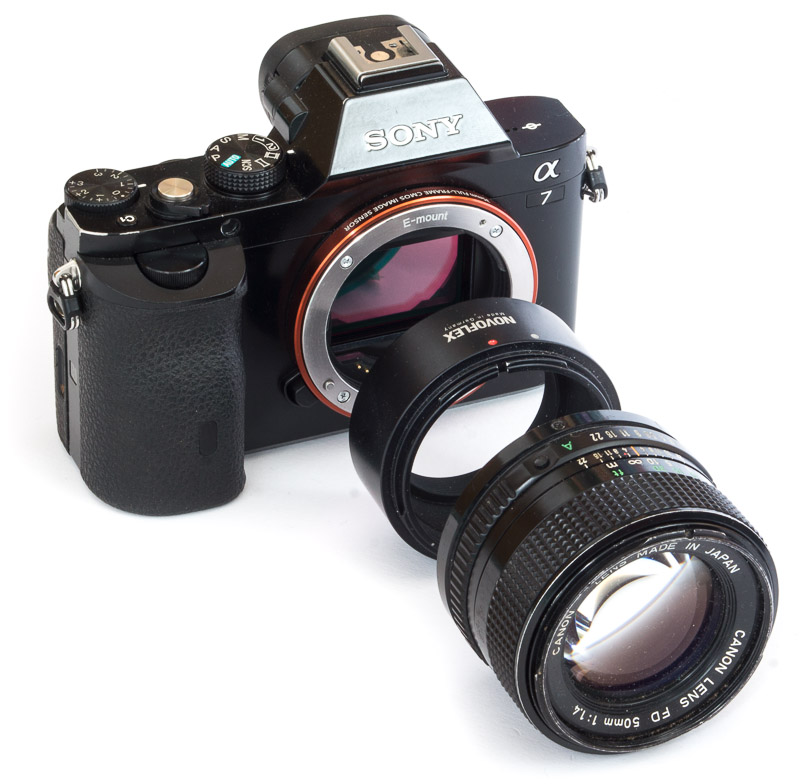
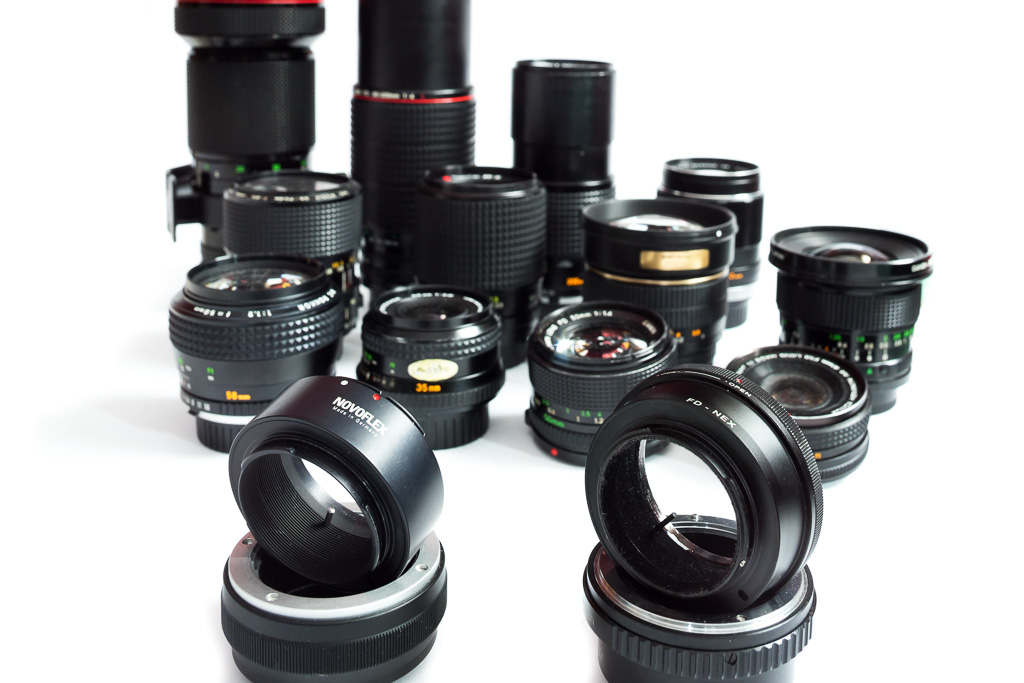

Dear Phillip. In you experience with adapters. Which adapter has less thickness than Novoflex. I contacted time ago. I have the Novoflex and a 28mm Canon FD f 2.0 (old version). And it does not focus to infinitum, it needs more. What adapter do you think could fix this detail? Amazing site for A7 owners. My photography is at http://www.Flickr.com/fjordan
I think I would buy a generic cheap adapter. It might be thin enough for your 2/28 but you could grind it so that it is thin enough.
Keep in mind…older lenses can get out of infinity + or -. Depending on use etc. Even new lenses do have different infinity positions.
I have a 7R with Carl Zeiss Contax C/Y :16, 28, 35, 50, 85, 135 and 200mm lenses.
None of them have infinity at the same position…although I have only 1 Novoflex adapter. And yes, the Novoflex is the best there is.
An Autocollimator is very useful for this 🙂
So I marked the real infinity position on my lenses.
Regards, Ivo
Hi dears,
I have a Contax lens Carl Zeiss 85mm F1.4 connected to an A7RII with a generic adapter of low quality, when I put the lens in F1.4 appears a huge flare or reflections, loss of contrast and impossible to focus, no matter the distance , The lens works best on F2 and F2.8 does not give problems.
Could it be that my problem is because the adapter reflects light? My idea is to buy a Novoflex adapter, have a nice weekend!
That could very well be an adapter problem.
Thanks for that article, due to that I didn’t bought a cheap adapter for 30$, instead I invest in a used novoflex… thanks!
Hey,
how do you get the information for aperture and focal distance listed on your Flickraccount (for example https://www.flickr.com/photos/birnenbaumgarten/16484270391/) ? I use the Novoflex Adapter on the Sony a-7 ii with a MD Rokkor 50mm f1,2 and the camera never knows which aperture I used for each picture. Thanks!
lenstagger will help you 😉
You swapped the amazon links for the Canon and Minolta versions, just so you know.
The one customer review on the Minolta version wasn’t very positive :/
Would you still recommend the Novoflex for Minolta lenses? I’m thinking about the Fotodiox (http://www.amazon.com/Fotodiox-Adapter-Minolta-Rokkor-E-Mount/dp/B003Y2YE62/)
Any input on that?
Keep up the good work with photos and your website 🙂
thanks for reporting that mistake.
I would still recommend the Novoflex adapter, in fact I bought a Minolta MD adapter from them last week. I own about a dozen cheap chinese adapters from various manufacturers but not one of them fits as well as the Novoflex and the older ones haven’t aged well. With the Novoflex I don’t have to worry about my adapter and it fits very well.
I got the fotodiox and I have to say first impression is great. Feels solid and fit perfectly to both camera (A7II) and lenses, no wiggle. We’ll see how it will age, but I’m happy with this one for now 🙂
I have another question. I see you use lenstagger to get the info on your photos, but how do you know what aparture and focal length (if zoom lens) you used for each shot? Do you just take mental notes?
I take mental notes 😉
Hei Philipp,
is your Novoflex MD/E-Mount-Adapter also set to perfect infinity focus?
Mine apparently is not 🙁
I alwys thought it was but just yesterday I tested it with my FD 2.8/24 and I achieve best infinty focus at the 3m setting. So no, it is not 🙁
The MD-Adapter measures from 25,40 to 25,44 mm where it should be 25,50 mm. :/
Turns out fixing the flange distance is not as straightforward as with cheaper adapters since the mount sits on a very narrow rim. Using aluminum foil will be rather finicky.
Selling mine http://www.dslr-forum.de/showthread.php?t=1623092
Hi Phillip,
I am about to purchase a Novoflex FD to nex adapter. Does this adapter attach Canon FD lens in the right up way just as you attach them on their native Canon FD cameras? This is important to me as I have a FD 15mm f2.8 lens which has a fixed lens shade/hood. Currently I have a no-name(well, it has a name) adapter but it attaches the lens in an angle and in turn the fixed lens shade will cast a couple of strange shadows in the frame. Therefore this adapter can’t be used for this fisheye lens but it can be used for almost any other FD lenses. Thank you in advance for your time and attention.
Regards
Xiaoxian
Hi Xiaoxian,
there is no angle and your fisheye should be fine.
Phillip
Phillip,
Love your site, I look forward to more content! As for the Novoflex adapter, one of the reviews on B&H photo stated that you had to set the aperture before mounting the lens and adapter onto the camera for some MD lenses. Is this true? That would really slow one down and honestly make me not want to use the lens at all.
I just purchased the Tokina AT-X 90mm f2.5 Bokina with Macro extender for Minolta MD mount and the Minolta 35-70mm f3.5 Macro on eBay and want to get the right adapter the first time. Its either the Novoflex or the Fotodiox. Any guidance would be appreciated greatly!
David
I am glad to hear that! I have very little time at the moent but I am optimistic to publish at least one article per week
Regarding the Novoflex: I think thats bullshit. I got my Novoflex MD adapter only two weeks ago but so far I had zero issues with the 15 or so lenses I used on it and also as far as I understand the mechanics it doesn’t make sense.
I wish you a lot of fun with the Bokina, it is a great lens.
Awesome! Ordering the Novoflex now. Like you, I like for something to just work, not worried so much about the premium price. Thanks!
Since I am retired (and cheap) I might be persuaded to buy a Novaflex adapter for Canon or Minolta lenses because of their bayonet (or “breech mount) flanges and the need for a good fit with the adapted lens. The price for a Novaflex M42 adapter, however, is just outrageous given that it is just a tube with a Sony flange on one end and a 42 millimeter screw thread tapped in on the other. If you had a Sony mount from a parts Nex camera, you could likely make an adapter yourself out of PVC pipe. Do you have any experience with 42mm adapters?
sorry, no experience with M42 lenses
excellent info on minolta lenses and adapters. thank you
One of the successful tricks I employ with cheap adapters is the addition of a black rubber band over the seam between the lens and the adapter. I purchased a mountain bike inner-tube from a bike shop. Using ordinary scissors I cut wide bands which I place over adapter seams that either do not fit perfectly or introduce reflection.
Hi, may I know if these same adapters work for A7ii as well? I’m not sure if the whole Sony A7 series share the same adapters. But thank you for sharing this post! 🙂
all a7 cameras (a7, a7r, a7s, a7 II, a7r II) share the same mount so the same adapters will work
This is sadly NOT correct for all adapters. Some were created in a way that will not fit on the A7ii, at least not without an insane amount of tightness. Guess that is part of maybe the cheaper designed ones but some popular sellers like Rainbow Imaging have specific ones listed for A7ii as their previous ones wouldnt fit correctly. I own both old and new so I speak from experience. 🙂
I am seriously considering now a Novoflex mainly for the reflections as I never considered that. Owning my new baby FD 300mm F2.8 I think it deserves the best possible adapter
Do you have a tutorial on how to fit an adapter on Sony a6000? Its a tricky process and I’m scared that I will damage something if I do not do it right. Would appreciate any leads of tutorial in this regard.
You can treat an adapter just like any lens, do you know how to change lenses?
I have a cheap leica and M42 mount adapter for my A6000 and A77 and they work perfectly. My take is: They are the same but the more expensive ones have better QA and thus it’s more likely you get a perfect adapter. Cheap doesn’t mean it doesn’t always work. It just means one works and the next is a little bit off – and there’re some really bad ones which you just stay away.
I’d say, just buy a couple of cheap adapters (same and different brands) from Amazon, test them out, keep the best one and send the others back. That’s very easy. You have to test Metabone or Novoflex as well. I actually brought a pricey Novoflex m-mount adapter first which didn’t work at all. I coudn’t focus on anything further away than 4 m. Then I got a cheap 10 or 15 € adapter from K&F Concept and it just works perfectly.
With Amazon you just have to be carefully where you order your adapter. You can order from Amazon directly, you can order from 3rd party with Amazon shipping and you can order from 3rd party with 3rd party shipping. Last one will probably cost you shipping cost when you send it back. And sometimes they send it from around the globe and it takes very long time. So beware where you order you adapter. And you should read the description and reviews. If you read something about reflections, scratch resistance, look and feel … that will also appear on your copy because it’s part of the build process. If you read something about focus accuracy, easy to mount … that might not effect you (or effect you even more) because that’s part of the build variations.
There’s no need to pay over 100 € for an tube, even if it has to be build very accurate. You pay for the convenience to just choose within one brand (you have to do testings anyways). If you have time for a little Amazon research, testing and returning, you can save a lot of money – and maybe buy more adapters or legacy lenses.
I still use cheap adapters but I also own one Novoflex for Canon FD and Minolta SR. One of my cheaper adapters which had worked great for 3 year broke and it took me one hour to remove it from a (loaned) lens. Anoher one took some force to remove it from my camera. So I bought the Novoflex because it is simply more reliable and I feel save from such misfortunes. For mounts which I don’t use often I still stick with the cheaper ones since the risk is much smaller.
A polish seller (eBay ciecio7) sells the same adapter for 40€, 1/3 of the price, and it does a perfect job too. They even have a version with tripod foot for 100€.
However, they have a more limited range and more oriented towards cine lenses. Would love to buy a good Leica or Olympus adapter from them, but chinese ones are OK too if one takes the time to properly shim them.
The trick is to find the ones that have real steel springs instead of just a slit that allows bending of the mount material. I have two from Big_is, Leica and Minolta, who are with proper springs, and others from the same seller without springs… go figure!
Hi Philip,
Great article and a great site! I recently acquired quite a few FD lenses after reading your reviews. I also bought a few no-name lens adapters but the internal reflection is terrible. What light absorbing materials did you use to solve this?
Thanks!
Maykel
i used this stuff in black: http://www.d-c-fix.com/velours-6065.html. I would vacuum clean it after you applied it to the adapter but then I had very few fibers on the sensor
Thanks for the info! I actually took it a step further and 3d printed a reflection blocking module to put in the adapter on which I applied the velour. Check it out
http://oi66.tinypic.com/33kydcm.jpg
Cheers
Did you notice any issues with the Novoflex adapter? I never managed to get noticable adapter flare with it
I don’t have the Novoflex adapter but a few no-name adapters. I figured let’s try to remove the internal reflections using various materials which turned out quite well.
Just an addition, which I would add:
What adapter is really useable in the end depends on the lens. If you use an old design which means that the lenses are in one solid block and don’t change distances to each other, when focusing, then you can use any adapter with different thicknesses (due you can issue infinity problems, or those decentering-like ones). It just depends on the distance between back lens and sensor, that’s all. And focusing with old lens design is just changing the distance between film/sensor and back lens. That is why the focal length also changes with focusing at those designs. It’s just one lens block moving.
But if you use newer designs like floating-lenses or Zoom then you really need to be aware of the thickness because it’s highly dependend on the flange focal distance (Auflagemaß?) how the lens performs, because it is build to be superior just at this one which is guaranteed by the lenses changing its distance to each other when focusing.
Well for me, who is highly using PB-Mount lenses, there is no Novoflex-Adapter, but those cheap ones do their stuff very well due its no problems because all those Prakticar lenses, except one, have this classic-lens-block-design. even decentering is not an issue here. But here I would take a look on the e-mount instead of the adapter, like you allready did 😉
You are right about lenses with floating elements, I had the Milvus 2.8/21 on a too short adapter and the corner performance was awful. But also my Canon nFD 2.8/24 performs worse on a too short adapter and shows a significant midzone dip. I hope to finish an article about adapters and how to tune them for the right thickness in the upcoming holidays.
If you are just that satisfied with your Novoflex FD-Mount adapter, then it could sometimes be interesting to also use it for lenses with M42 screw mount, right? Canon itself build a team of mount converters for their FD cameras, which are of very high quality (but all have a “cream-silver” finish, not mate black). First I read about it on this website:
https://www.cameraquest.com/nikonaf.htm
The Canon Lens Mount Converter P and E are still affordable. I own both and use it to mount a big variety of lenses on an expensive (and well made) Metabones Speedbooster FD/FX (Fuji X). So I have one adapter to use with Canon FD, Asahi Pentax, Carl Zeiss Jena, Meyer Görlitz, Topcon Topcor RE…
The Lens Mount Converter N is not affordable, but there is a chinese copy, sold directly from Hong Kong by Roxsen, but not of the original Canon quality. For my speed booster use it is ok, on a Sony A7 every cheap native adapter from Nikon Ai (or AF-G) to Sony E will perform better.
I have a question: I bought this adapter and an old Canon 50 1.4 (don’t know the exact year of build) with FD. My problem: with this adapter I have only 1.4 as aperture. Is there a trick or do I have to buy the version with separate control ring with open ans close?
Thanks, Stephan
it is a bit tricky to mount a FD lens to that adapter so let me walk you through it. When you have mounted the lens correctly you can control the aperture but you can also mount it wrong and then you can’t control the aperture
Is it your practice to have an adapter for each lens and leave it on that lens more or less permanently? In other words, you would have an adapter for each of your Minolta MD lenses. Or do you remove the adapter from one lens and put it on another when you go to use it? I have Nikon F mount lenses, and I’d prefer not to have to have an adapter for each lens, but I will if that is recommended.
I really enjoy your articles and photos. Have you seen the work of my fellow Canadian in Toronto, Yu-Lin Chan, who does amazing adaptations of old lenses on the Sony A7? He is at http://oldlenses.blogspot.ca/
Nowadays I have one Novoflex Adapter for the mounts most important to me and I switch lenses not adapters and lenses
Thanks Phillip for the info.
Have you tried the Rayqual adapters from Japan?
They seem just as precise as the Novoflex (similar price). My C/Y-E is exactly parallel.
But they have one advantage: they have a very complicated series of masks and baffles in them which means that you are as protected from adapter induced flare of reflections as is possible
Not yet but when I decide to buy a high quality adapter for C/Y or Om I might give them a try
I own 2 Novoflex adapters (NIK/NEX) with collar and sadly when I started testing my Otus 28mm at 1.4 it showed differences when compared to native ZF.2 mount. The right side was kinda blurry (not that much, but noticable).
I’m curious why you chose f11 to conduct your test? Shouldn’t you be doing that with maximum aperture and with fast lenses like 1.4?
Yeah, that would be a much more demanding test. The issue though is that the older super wides need to be stopped down quite far to reach good corner sharpness, there is simply no wideangle in FD mount which has sharp corners at wider apertures. So the FD 2.8/20 at f/11 was the most demanding test I could come up with when I wrote the review. Your Otus would be much more demanding but one test isn’t enough to be sure that the adapter is to blame for your issues. Could be the mount of the camera as well.
Nice review! But how did you managed to coat the noname adapter with a light absorbing material and what material was it?
SOme d-fix felt material
I enjoyed using the novoflex adapter with different fd lenses but returned it because i think its overpriced. Nonetheless a comparision between the novoflex and the much cheaper k&f adapter showed better results with the fd 17mm in terms of corner sharpness which is a huge plus for novoflex of course. Anyone with similar observations?
That make sense since the Novoflex is better (not perfect) at maintaining the flange focal distance.
Hey,
What do you think about the Voigtlander VM II adapter vs Novoflex for Sony a7? Is Novoflex just as good? I have a problem mainly with Leica lens interfaces (vignette) after connecting to Sony a7. I am currently using Haoge Helicod. Do you think that more expensive adapters improve errors that are at cheaper corners, etc.?
Thanks.
Would you mind sharing a photo showing the issue?
In general vignetting issues with wide angle rangefinder issues are not that uncommon, see this article.
I doubt it is an issue with the adapter, albeit every cheaper helicoid adapter (even the ones going up to 170$) I tried was very bad.
Hi Philip, have you ever heard of Shogun Adapters, if yes do you know how it’s with their quality, its really hard to find anything about them
Nope.
Dear Phillip,
have you any suggestion for a nikon to sony full frame adapter?
I really don’t care abut aperture ring or AF, I just need a good adapter that keep the lens in place!
I have used for a while a K&F nik(g)>NEX but it’s not keeping stable the lens…
thanks!
Can you elaborate what lenses you intend to use and what exactly is unstable with the K&F adapter?
I’m an old timer amateur photographer 40 years now, using older ziess yc mount lenses with the novoflex adapter to the sony a7rll, from what data is available on the network this appears to be a very good combination for a manual focus set up. Past has been with Contax RTS film bodies.
Adapters are available for many camera / lens combinations.
I sincerely hope this will help support decisions.
Not being critical in any way shape or form, information and experience only.
Hi All,
I know I am late to the game with a question…
I’m sure this works great with cameras without IBIS. Does anyone know if IBIS keeps an accurate flange distance during operation? And when IBIS is turned off?
I can imagine it adding a new dimension to the compatibility equation (pun intended).
IBIS doesn’t cause any issues with flange distance.
For your info, I tested this week a 7artisans adapter to fix Leica M lenses to Nikon Z cameras. It’s very solidly build, good finish, good aluminium construction, but if there is enough tolerance in the Z side bayonet (it’s easy to fix the adapter to the camera without play), there is absolutely no tolerance to be able to fix Leica lenses to the adapter. With the 21mm f:2.8 and the 28mm f:2.8, you have to force a lot just to introduce the lens in the adapter, than it’s impossible to turn the lens. With the 35mm f:1.4, 50mm f:1.4 and 75mm f:1.5, it’s just a little bit easyer to put the two bayonets in contact, but than it’s very difficult to turn the lens and impossible to reach the lock position without forcing.
Thank’s for all the infos on your site,
Pierre Hilgers (Belgium)
I have a Sony a7riii camera and have used a cheaper Leica m to sony e mount adapter to adapt Leica m mount lenses to the camera. What I find very puzzling is that, with the adapters in use, the focus distance scale on the m mount lenses are wildly inaccurate. For example, I can hand focus the lens to a subject at, say 3 meters, yet the lens distance scale says the lens is focused at a substantially different distance. Sometimes the actual distance and the distance read on the lens distance scale are somewhat in the same ballpark but at other times there are major differences. This happened with a Minolta 28mm 2.8 m rokkor lens and with the latest model Voightlander 28 2.0 Ultron lens. Would buying a better adapter, like a Novoflex, provide an accurate result? I ask because I am using zone focusing and accuracy in distance estimation is important. Thanks so much.
There are 2 things to consider here:
a) The accuracy of the distance scale isn’t great. This is more noticeable with a high resolution camera you are using, your expectations may simply be too high.
b) The accuracy of the length of the adapter. Most adapters are deliberatly being produced a bit too short to avoid returns (people will very likely return an adapter if they cannot focus at infinity but are unlikely to return it only because the distance scale is off).
Focus at something as far away as possible and check if the lens is at the infinity hard stop or way before that (e.g. 3.0 m). If the latter is the case a better adapter should help you.
For Leica M lenses my recommendation is getting a metabones Leica M -> Sony E adapter.
They are the most accurate I came across, I have two of these myself for that very reason.